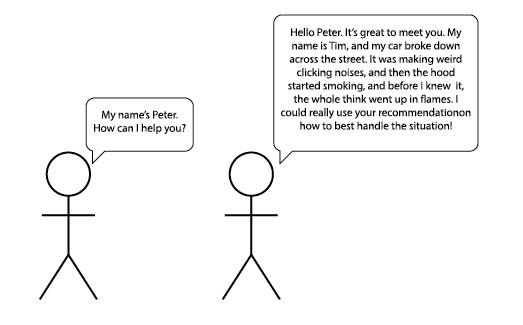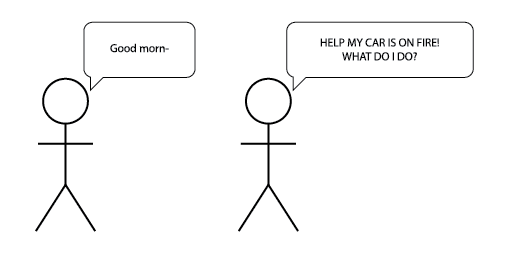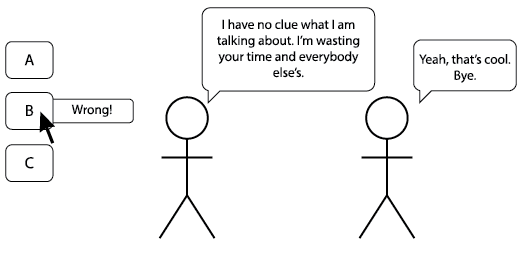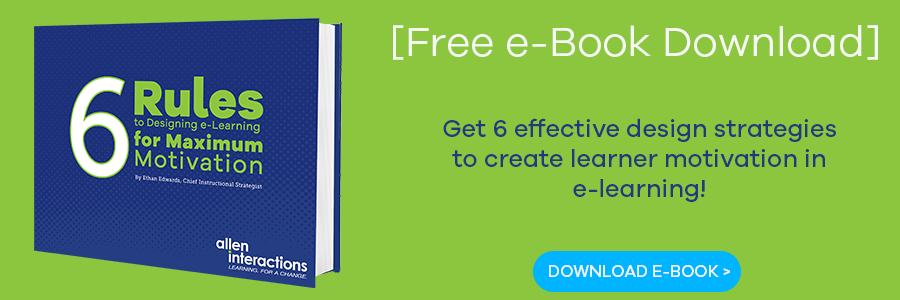Blog
A Talent Ecosystem for the Now of Work
By Erik Sabol, Senior Instructional Writer You’re an expert on great dialogue. Seriously. Right now. No further training required. You’ve been ...


Three Tenets for Writing Exceptional e-Learning Dialogue
By Erik Sabol | April 13, 2016 | Custom Learning | 0 Comments
By Erik Sabol, Senior Instructional Writer
 You’re an expert on great dialogue.
You’re an expert on great dialogue.
Seriously. Right now. No further training required.
You’ve been practicing your entire life. You order coffee, make phone calls, and discuss Game of Thrones like a dialogue-writing prodigy. And you do it all with words that are concise, authentic, and specific to your personality.
There’s no mystery to great dialogue. It’s everywhere.
But why don’t we see it more often in our movies, books, and online training? Why is our creative media bogged down with banal, confusing, out-of-character dialogue?
Because they ignore basic principles of human speech and interaction. It’s an easy trap to fall into. You don’t want bad dialogue to be the most memorable thing about your e-learning, so follow these three tenets to stand out from the crowd:
1. Write like you speak.
A lot of times, in e-learning, we try to cram as much information into our dialogue as possible.

People don’t speak this way.
The conversations we have in real life are full of information, but it’s rarely delivered through extra words. Instead, we use implication, tone, and/or body language.
By cutting unnecessary words, you add punch and clarity to your dialogue.

Your learners can figure out a lot about a scene via the visuals and context. They don’t need a character to say, “Welcome to your local grocery store! We sell the freshest vegetables and choicest cuts of meat, and we always put our customers first!”
Cram too much information onscreen and it’ll have the opposite effect. Learners will lose interest, skim the dialogue, and miss the point entirely.
So keep it short. Concise. Let the learner infer the little details. Remember, human beings rarely say exactly what they mean, and when they do, they use very few words.
Read your writing out loud. If it sounds stiff or unusual, rewrite it. That’s Rule #1 of great dialogue.
2. Empathize with your characters.
People are complicated beings. Our unique backgrounds and situations define the way we use words. Your phrasing, speech patterns, and mannerisms change when you’re in the office or at the bank.
Or maybe they don’t.

And that says a lot about you.
The characters in your online training aren’t .png files. They aren’t set pieces or vehicles for the learning. They’re humans. And they don’t always have to be enthusiastic, or respectful, or grammatically flawless when they speak. Whenever possible, their dialogue should communicate opinions, insecurities, emotional states, biases, fears, and aspirations.
How do you capture all of that in as few words as possible? By empathizing with the people you write into your training. By understanding their motivations and backgrounds, and bringing that forward through their dialogue.
After all, someone who says, “I need to pass the test,” is in a very different place than one who says, “I can’t afford to fail.”
3. Use dialogue to convey feedback.
Write dialogue that’s both conversational and empathetic to add flavor to your e-learning. But what about learning-relevant depth? Can you convey actual lessons and instructional points through dialogue?
Of course. Why craft strong dialogue if you don’t expect it to do any heavy lifting?
In life, most conversations don’t end when we say the wrong thing. Your e-learning shouldn’t be any different.
 There are consequences to the things we say. Reactions. Feedback. If you’re evaluating someone’s abilities within the context of human interaction, don’t tell them whether they’re “Right!” or “Wrong!” There’s no learning moment there. Instead, show the consequences of their choice.
There are consequences to the things we say. Reactions. Feedback. If you’re evaluating someone’s abilities within the context of human interaction, don’t tell them whether they’re “Right!” or “Wrong!” There’s no learning moment there. Instead, show the consequences of their choice.
Great dialogue can drive home lessons that buzzers, checkmarks, and smiley faces can’t. A character saying, “I’m sorry, we’re on totally different wavelengths,” or conversely, “I feel like someone’s finally listening to me,” can replace an entire paragraph of expository feedback.
Or don’t.
Look. You don’t need three-dimensional characters to inspire performance change in your learners. You don't need compelling dialogue. You do, however, need learner engagement. And exceptional dialogue is an easy way to make learners care about your training.
You’ve already got the characters on screen. They’re taking up space and drawing attention. Make them more than intermediaries for your content. Give them a voice. Let them speak. They’ll say some remarkable things.
LIKE WHAT YOU'VE READ? SHARE THE KNOWLEDGE WITH YOUR PEERS USING THIS READY-MADE TWEET!
CLICK TO TWEET: Three Tenets for Writing Exceptional #eLearning #Dialogue http://hubs.ly/H02Fb4b0 #aiblog
About the Author: Erik Sabol
Comments
Would you like to leave a comment?
Related Blog Posts

By: Erik Sabol | Jun, 2020
Category: Custom Learning, Strategic Consulting

Blog
On the Road with Ethan Edwards... In Birmingham, Alabama!
By Erik Sabol, Senior Instructional Writer You’re an expert on great dialogue. Seriously. Right now. No further training required. You’ve been ...
By: Erik Sabol | Nov, 2018
Category: Custom Learning

Blog
Don't Create e-Learning No One Wants...Lessons From Holiday Sweaters
By Erik Sabol, Senior Instructional Writer You’re an expert on great dialogue. Seriously. Right now. No further training required. You’ve been ...
By: Erik Sabol | Dec, 2014
Category: Custom Learning

